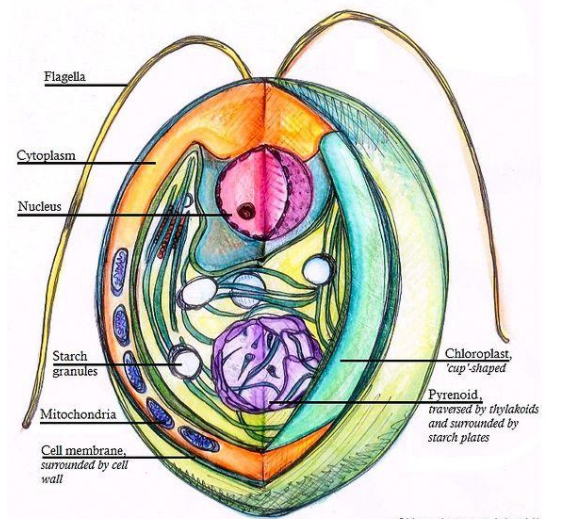
In most green algae, pyrenoids, the storage bodies are located in................
A) Chloroplasts
B) Mitochondria
C) Cytoplasm
D)nucleus
Answer
499.2k+ views
Hint: Green algae are phototrophic organisms. They strictly live in aqueous environment. They have carbon dioxide fixing enzymes.
Complete answer:
To answer this question, we must know about the structure of green algae.
>Green algae are the photoautotrophic eukaryotic organisms which strictly live in aqueous environment. The green algae are unicellular and colonial organisms which have one or more flagella. They have a well defined nucleus and cytoplasm. The cell wall contains cellulose and they store carbohydrate as starch. Most of them reproduce asexually by fission and sexually by alternation of generations. Green algae have two types of chloroplast a and b giving them bright green colour and also have accessory pigments like beta carotene and xanthophylls. Pyrenoids are subcellular microcompartments present in the chloroplast of hornworts. It was first described by Vaucher. Its main function is it is the centre of carbon dioxide fixation. It maintains a carbon dioxide rich environment around photosynthetic enzymes. It is the centre for active transport of bicarbonate from extracellular environment to chloroplast membrane and thylakoid.
>Mitochondria- It is the powerhouse of the cell. They have mitochondria with flat cristae.
>Nucleus- Green algae have a very well defined nucleus. The nucleus contains the genetic material.
>Cytoplasm –Cytoplasm comprises all the organelles. Nucleus, chloroplast, mitochondria are present in the cytoplasm.
Thus the correct answer is (A) Pyrenoids are located in Chloroplasts.

Note: Green algae belong to kingdom plantae but lack a well differentiated body. They have two types of pigments chlorophyll a and b. Some green algae have pyrenoids in the chloroplast which are the important centre for fixing carbon dioxide.
Complete answer:
To answer this question, we must know about the structure of green algae.
>Green algae are the photoautotrophic eukaryotic organisms which strictly live in aqueous environment. The green algae are unicellular and colonial organisms which have one or more flagella. They have a well defined nucleus and cytoplasm. The cell wall contains cellulose and they store carbohydrate as starch. Most of them reproduce asexually by fission and sexually by alternation of generations. Green algae have two types of chloroplast a and b giving them bright green colour and also have accessory pigments like beta carotene and xanthophylls. Pyrenoids are subcellular microcompartments present in the chloroplast of hornworts. It was first described by Vaucher. Its main function is it is the centre of carbon dioxide fixation. It maintains a carbon dioxide rich environment around photosynthetic enzymes. It is the centre for active transport of bicarbonate from extracellular environment to chloroplast membrane and thylakoid.
>Mitochondria- It is the powerhouse of the cell. They have mitochondria with flat cristae.
>Nucleus- Green algae have a very well defined nucleus. The nucleus contains the genetic material.
>Cytoplasm –Cytoplasm comprises all the organelles. Nucleus, chloroplast, mitochondria are present in the cytoplasm.
Thus the correct answer is (A) Pyrenoids are located in Chloroplasts.

Note: Green algae belong to kingdom plantae but lack a well differentiated body. They have two types of pigments chlorophyll a and b. Some green algae have pyrenoids in the chloroplast which are the important centre for fixing carbon dioxide.
Recently Updated Pages
Master Class 9 General Knowledge: Engaging Questions & Answers for Success

Master Class 9 English: Engaging Questions & Answers for Success

Master Class 9 Science: Engaging Questions & Answers for Success

Master Class 9 Social Science: Engaging Questions & Answers for Success

Master Class 9 Maths: Engaging Questions & Answers for Success

Class 9 Question and Answer - Your Ultimate Solutions Guide

Trending doubts
State and prove Bernoullis theorem class 11 physics CBSE

What are Quantum numbers Explain the quantum number class 11 chemistry CBSE

Who built the Grand Trunk Road AChandragupta Maurya class 11 social science CBSE

1 ton equals to A 100 kg B 1000 kg C 10 kg D 10000 class 11 physics CBSE

State the laws of reflection of light

One Metric ton is equal to kg A 10000 B 1000 C 100 class 11 physics CBSE




